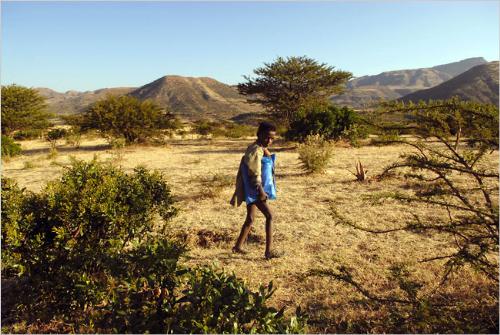|
|
|
Amigos w/ Common Interests
|
|
|
|
|
|
|
|
|
|
|
|
|
|
|
|
|
|
<<
View Prev Image
|
|
|
|
View Next Image >>
|

Category: Food and Drink |
|
|
A malnourished and underdressed boy walks to school. In labor-driven Ethiopia, many children grow up starved and brain damaged
PHOTO NYTIMES
PART 2 of 3
Well over half of sub-Saharan children under 5 lack iron, vital to developing nervous systems, the Micronutrient Initiative, a Canadian research organization, reported in 2004. They often have trouble concentrating and coordinating brain signals with movements, like holding a pencil, that are crucial to education.
Another 3.5 million children lack sufficient iodine, which can lower a child’s I.Q. by 10 or more points. More than a half million suffer vitamin A deficiency, which cripples young immune systems; merely ensuring adequate vitamin A can lower child mortality by more than one- fifth. Children lacking vitamin B12, regularly measured nowhere in Africa, have impaired cognitive skills and do poorly on tests.
In most foods, these vital nutrients exist in traces — vitamins A and B12, iron, iodine, folic acid. Denied them in the womb and in infancy, children suffer irreversible brain and nervous-system damage, even if they appear well fed.
“Even trained people can’t always see them,” said Mark Fryars, the director of program services for the Micronutrient Initiative. “You may see a kid whose skin is very pale. You may go into a classroom where a child wanders off, or falls asleep, or doesn’t go out to play because he’s too tired. Multiply that into whole villages, and that translates into an impact on the society.”
In richer parts of the world, nutritional deficiencies are a nonissue. Three percent of American children are malnourished. American flour and cereals have been fortified with vitamins and iron — by law — since the 1930s.
In sub-Saharan Africa, however, lost productivity from vitamin and mineral deficiencies costs nations $2.3 billion a year, Unicef reports, and losses of productivity in Mozambique, Zambia and Malawi exceeded 1 percent of gross domestic product.
Many African children sometimes receive nutrient supplements, courtesy of the World Food Program, Unicef and charities. Still, donors cannot meet the need. In Ethiopia, for example, a venture between the government and United Nations agencies is caring for 20,000 acutely malnourished children at 100 sites.
“But we can count 70,000,” said Iqbal Kabir, the chief nutrition expert at Unicef offices in Addis Ababa, Ethiopia’s capital. “We can’t treat them all.”
Shimider is but a hundred or so stone and reed homes, one room each, in a mountain valley in the Amhara region, 250 miles north of Addis Ababa. The slopes here have been intensively farmed for thousands of years, and their soils are exhausted.
Twenty-two years ago, a famine here killed more than one million people. Today, hunger is measured in squandered lives.
Thirty percent of Amhara’s children under 5 are stunted, with another 26 percent severely stunted, evidence of lifelong, acute hunger. One in 15 pregnant women experiences night blindness, indicating vitamin A deficiency and a diet devoid of protein and red or yellow fruits and vegetables.
Among both malnourished children and their mothers, the impact of such privation is achingly evident.
One recent Sunday, Tewres Beram, a woman in her early 20s, carried her daughter Mekdes to a free immunization clinic. Mekdes, severely malnourished, sat suckling fruitlessly at her mother’s breast. “We don’t have enough food,” her mother said, “so there’s not enough milk to feed her.” A year old, Mekdes does not crawl. Her sister, 2, has barely begun to crawl. “Both of them are like little dead bodies,” their mother said.
Sirkalem Birhanu, 40, clasps Endalew, age 2 and unable even to hold up his head. “He’s always sick,” she said. Endalew has company, she said; his 13-year-old brother “is very tiny, and he loses weight.”
“And he’s always been sick,” she added.
And there is Berhane Gebeyew, 36, whose malnourished 18-month-old daughter, Genet, is a lump in her lap, despite receiving six months’ worth of fortified food last May from the governments.
Mrs. Gebeyew split the food among Genet and her four siblings, ages 6 to 15. “The other children, when they stare at my eyes, I give it to them,” she said.
She and her husband feed their children two daily meals of injera, a spongy flatbread of fermented barley, occasionally with four ounces of bean sauce. When the children attend Shimider Primary, each gets 10 ounces of vitamin-fortified meal mixed with cooking oil. But attendance is spotty, especially when they help harvest crops in November and December.
And by the time children reach school age, much of malnutrition’s damage has already been wrought.
CONCLUDES NEXT IMAGE |
|
|
|
|
|
| |
|
|
|
|
|